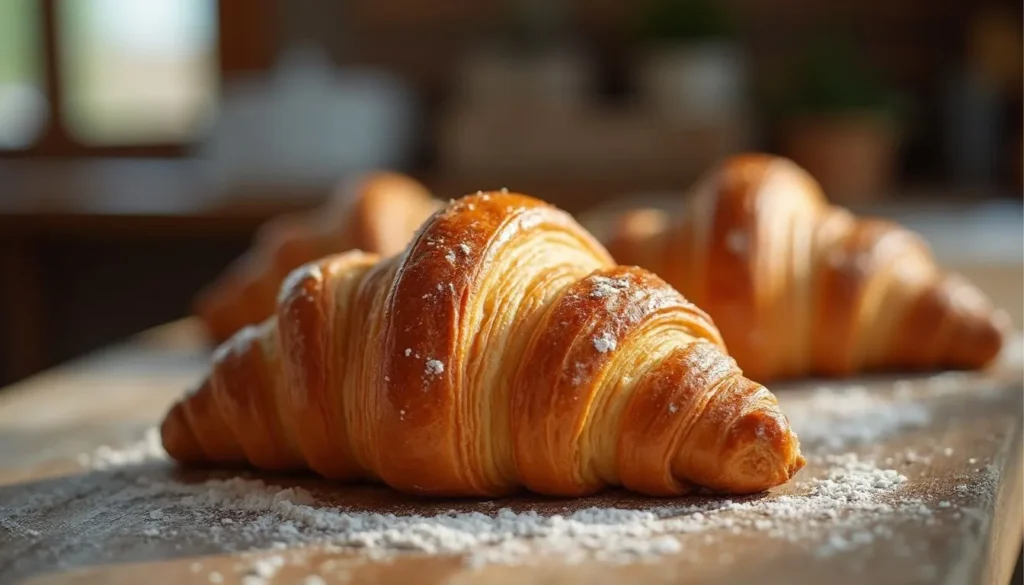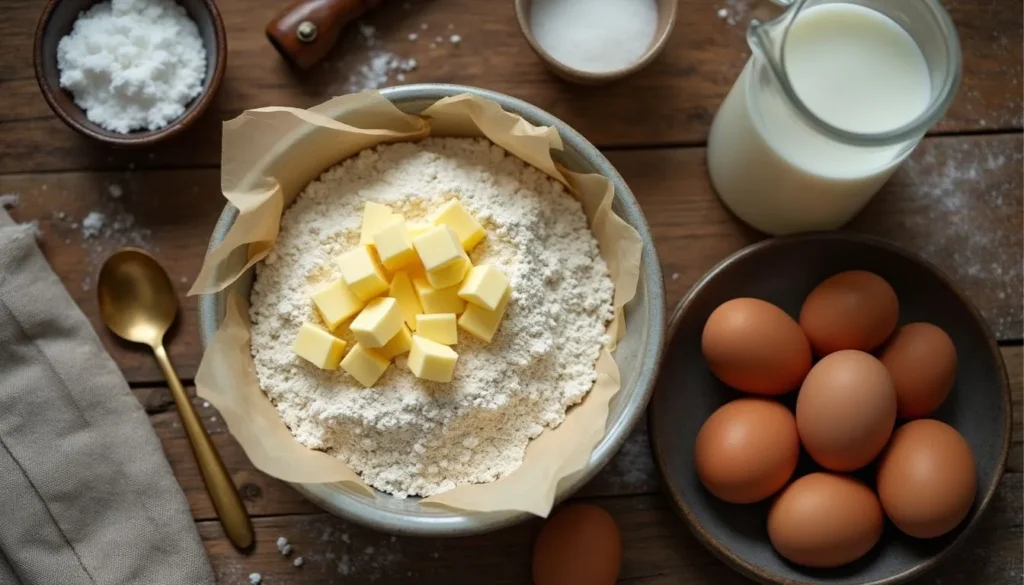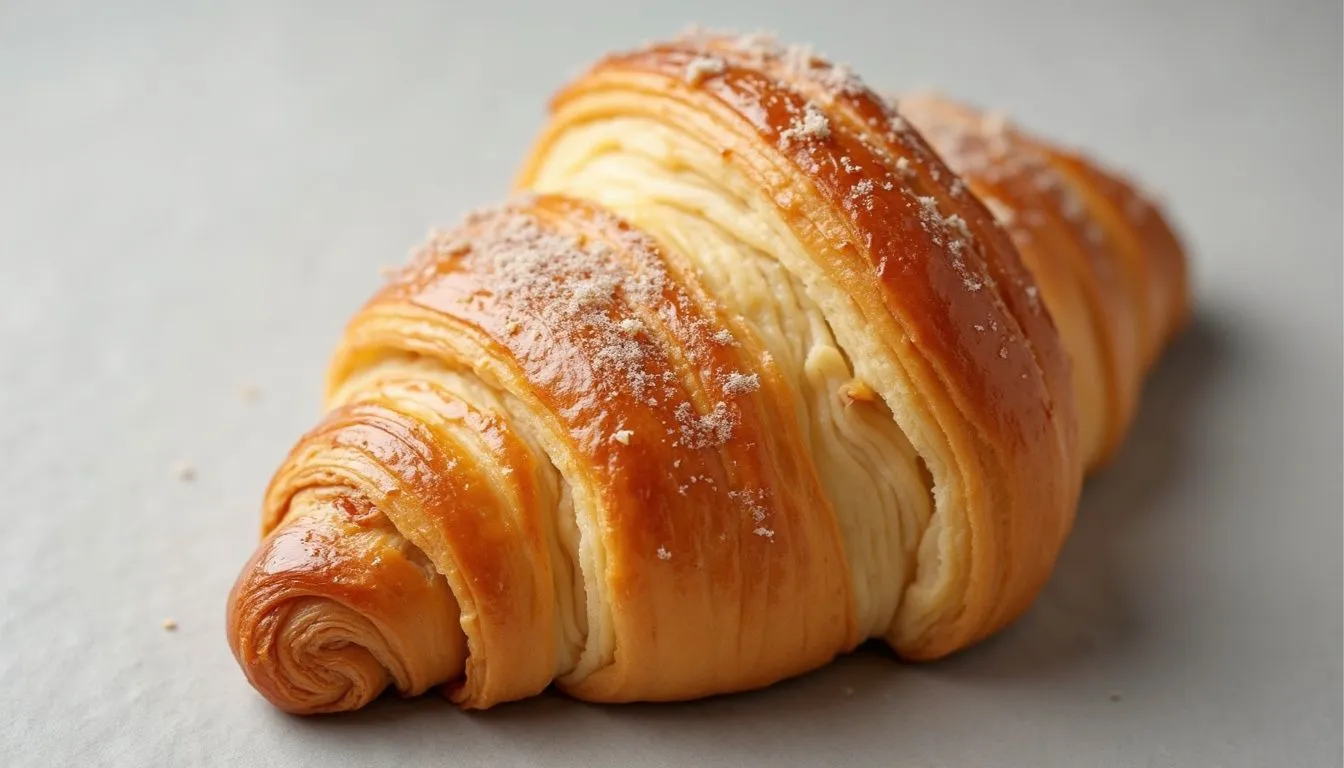The first time I bit into a freshly baked Swiss butter croissant, I found something special. It was the gipfeli. This Swiss pastry won my heart with its unique texture and rich history.
Imagine making Swiss bakeries’ warmth come alive in your kitchen. This gipfeli recipe turns simple ingredients into a flaky, golden treat. It’s a journey into Swiss culinary tradition, perfect for both passionate bakers and curious foodies.
Swiss bakers have honed this pastry over generations. It’s a treat that’s both familiar yet uniquely Swiss. Each gipfeli is a piece of Switzerland’s baking heritage, ready to be explored in your kitchen.
Table of Contents
Understanding Swiss Gipfeli: A Croissant’s Alpine Cousin
Explore the world of Swiss baked goods and find out about Gipfeli. This pastry is a Swiss breakfast favorite. It looks like a croissant but has its own special taste and history.

In Swiss German, ‘Gipfeli’ means ‘small summit.’ It looks like Alpine peaks. These pastries are more than breakfast. They are a symbol of Swiss baking traditions.
Origins and Cultural Significance
The Gipfeli’s story is interesting. It started in Switzerland and mixes different baking styles. It shows the country’s love for food, blending Austrian and French methods with a Swiss twist.
- Developed in Swiss bakeries during the 19th century
- Inspired by Austrian and French pastry-making techniques
- Represents regional culinary innovation
What Makes Gipfeli Different from Croissants
Gipfeli and croissants look similar but are not the same. Gipfeli are less buttery and more compact. They have a unique shape and taste.
| Characteristic | Gipfeli | Croissant |
|---|---|---|
| Shape | Compact, slightly curved | More pronounced crescent |
| Butter Content | Less rich | More buttery |
| Texture | Firmer | More flaky |
Traditional Role in Swiss Breakfast Culture
In Swiss homes, Gipfeli are a morning tradition. They are enjoyed with coffee or tea. These pastries bring comfort and start the day off right.
Essential Ingredients for Authentic Gipfeli

To make perfect buttery croissants, you need the right ingredients. The success of your Gipfeli depends on using top-notch ingredients. These ingredients work together to create those flaky layers everyone loves.
The base of a great Gipfeli is premium ingredients. Each part is key to the delicate texture and rich taste Swiss bakers have mastered over time.
Core Ingredients for Exceptional Gipfeli
- All-purpose flour (unbleached preferred)
- Warm milk
- Granulated sugar
- Fine sea salt
- Instant active dry yeast
- Unsalted European-style butter
- Large eggs
When picking butter for your dough, choose high-fat European-style butter. This is key for those buttery croissants with many layers.
Ingredient Quality Breakdown
| Ingredient | Quality Impact | Recommended Type |
|---|---|---|
| Butter | Determines flakiness and flavor | High-fat European butter (82-85% butterfat) |
| Flour | Provides structure | Unbleached all-purpose or bread flour |
| Yeast | Enables rising | Instant active dry yeast |
Your choice of ingredients affects your Gipfeli’s texture and taste. Choose quality ingredients for a true Swiss pastry experience.
Professional Tools and Equipment Needed
Making delicious bakery recipes like Gipfeli needs the right tools and equipment. Whether you’re new or experienced, the right tools make perfect puff pastry easy. Let’s look at the essential tools for making authentic Swiss Gipfeli at home.
Preparing puff pastry needs precision and the right tools. These tools make your baking journey smoother.
Must-Have Baking Tools
- Rolling Pin: Essential for creating thin, even layers of dough
- Pastry Brush: For applying egg wash and creating golden-brown surfaces
- Baking Sheet: Provides a stable surface for baking your Gipfeli
- Parchment Paper: Prevents sticking and ensures easy cleanup
- Sharp Knife or Pastry Cutter: For precise dough cutting and shaping
Optional but Helpful Equipment
- Stand Mixer: Simplifies dough preparation
- Dough Scraper: Helps manage sticky dough
- Silicone Baking Mat: Alternative to parchment paper
- Bench Scraper: Assists in dough handling and cleaning work surfaces
Measuring and Temperature Tools
Accuracy is key in bakery recipes, like with delicate puff pastry. Invest in these tools for consistent results:
- Digital Kitchen Scale: Provides precise ingredient measurements
- Instant-Read Thermometer: Monitors dough and butter temperatures
- Measuring Cups and Spoons: For accurate ingredient proportions
While professional equipment helps, passion and practice are key. They are the most important ingredients in creating perfect Gipfeli.
Gipfeli Recipe: Step-by-Step Instructions
Making the perfect gipfeli recipe needs precision and patience. The laminated dough is key, requiring careful technique and detail. Start your journey to making this Swiss pastry by understanding each step.
Let’s break down the gipfeli recipe into manageable stages:
- Prepare the Base Dough
- Mix flour, yeast, sugar, and salt
- Gradually add cold milk and eggs
- Knead until smooth and elastic
- Lamination Process
- Roll out chilled butter into a thin rectangle
- Fold dough around butter to create layers
- Perform three consecutive “turn” techniques
- Shaping the Gipfeli
- Roll laminated dough to 1/8 inch thickness
- Cut into triangular shapes
- Roll from wide end to create signature crescent
Professional bakers stress the importance of temperature control. Keep your work surface cool and work quickly to keep the butter intact. Chill the dough between turns to get those flaky layers that make gipfeli so tempting.
Your final gipfeli should have multiple delicate, buttery layers that melt in your mouth. With practice, you’ll make bakery-quality Swiss pastries in your own kitchen.
Mastering the Lamination Process
Creating flaky, delicate puff pastry needs precision and skill. Your success with Gipfeli depends on making perfect layers of dough. These layers give the pastry its light texture.
The art of lamination turns simple ingredients into a magical pastry experience. Your technique will make or break those crisp, buttery layers. These layers are what make Gipfeli so irresistible.
Creating Perfect Butter Layers
To achieve perfect butter layers, focus on a few key factors:
- Use high-quality European-style butter with higher fat content
- Ensure butter is cold but pliable
- Roll butter between parchment paper to create an even sheet
- Maintain consistent thickness throughout the lamination process
Temperature Control Techniques
Temperature management is key when working with laminated dough. You want to keep the butter and dough at the right consistency.
| Temperature Range | Dough Condition | Recommended Action |
|---|---|---|
| Below 60°F | Butter too cold | Let dough rest at room temperature |
| Above 70°F | Butter too soft | Refrigerate for 15-20 minutes |
| 65-68°F | Ideal working temperature | Begin lamination process |
Folding Methods for Flaky Results
Mastering the folding technique is key for flaky layers in your puff pastry. Practice the classic turns method:
- Perform a single turn (letter fold)
- Rotate dough 90 degrees
- Roll out to original dimensions
- Repeat turns 3-4 times with chilling between each turn
By mastering these lamination techniques, you’ll make your Gipfeli extraordinary. You’ll create pastries with amazing texture and flavor.
Sweet and Savory Variations
Swiss baked goods like Gipfeli are perfect for breakfast pastry fans. The classic version is loved by many. But, trying new flavors can make baking even more fun.
Sweet versions of Gipfeli add excitement to these Swiss treats. Here are some tasty options:
- Chocolate-filled Gipfeli with rich dark chocolate
- Jam-packed versions using local Swiss fruit preserves
- Nutella-inspired creations for chocolate lovers
- Almond paste fillings with delicate sweetness
Savory fans can also find amazing twists on these Swiss treats. Try these unique fillings:
- Herb-infused cheese Gipfeli
- Prosciutto and gruyère combinations
- Smoked salmon with cream cheese
- Spinach and feta variations
When making your Gipfeli, keep temperature and technique in mind. Keep your butter cold and your dough well-laminated for the best results.
Your Gipfeli is great for any time or event. Whether you want a sweet start to the day or a fancy brunch item, these pastries offer amazing taste and texture.
Tips for Perfect Golden-Brown Results
Making buttery croissants needs precision and care. Your recipes will stand out with the right golden-brown finish. The right methods can make your Gipfeli truly special.
Getting bakery-quality results is all about mastering key baking principles. Success depends on three main things: proofing, temperature, and visual signs.
Proofing Techniques for Optimal Rise
Proofing is key to making croissants light and airy. Here’s what to do:
- Proof in a warm, draft-free spot
- Keep dough moist with a damp cloth
- Let it proof for 1-2 hours
- Make sure it’s doubled in size
Precise Baking Temperature Guidelines
| Temperature | Baking Time | Expected Result |
|---|---|---|
| 375°F (190°C) | 15-20 minutes | Golden-brown exterior |
| 360°F (182°C) | 18-22 minutes | Softer, less intense color |
Visual Cues for Perfect Doneness
Knowing these visual signs will help your bakery recipes:
- Color: Aim for a rich, even golden-brown
- Texture: The surface should be crisp and shiny
- Layers: Look for clear, buttery layers
By using these professional tips, your Gipfeli will look and taste like they’re from a Swiss bakery.
Storage and Reheating Methods
Keeping your homemade gipfeli fresh is key. Enjoy your swiss butter croissants within a few days for the best taste. But, with the right storage, you can make them last longer.
For short-term storage, keep your gipfeli in an airtight container at room temperature. This way, they stay crisp on the outside and soft on the inside for 1-2 days.
- Room temperature storage: 1-2 days
- Use an airtight container to prevent moisture
- Keep away from direct sunlight
Freezing is great for longer storage. Wrap each pastry in plastic wrap, then in a freezer-safe bag. They can stay frozen for up to a month, keeping their quality.
When reheating, be gentle to keep the pastry’s texture. Preheat your oven to 350°F (175°C). Here’s how to do it:
- Remove pastry from freezer and let thaw for 10-15 minutes
- Place on a baking sheet
- Warm for 5-10 minutes until crisp and golden
Pro tip: Avoid microwave reheating, as it can make your swiss butter croissant soggy and compromise its delicate layers.
Conclusion
Learning to make gipfeli opens a door to Swiss cuisine. It turns a simple morning into a Swiss food adventure. Every step, from folding to baking, connects you to Swiss baking history.
Gipfeli are great for any time of day. They add Alpine charm to your meals. Your homemade gipfeli will wow everyone with their quality and taste.
Try different fillings to make gipfeli your own. You can fill them with butter, chocolate, or ham. This lets you express your creativity in Swiss baking.
Don’t worry if it takes practice to get it right. Each try makes you better at making gipfeli. Your hard work will pay off with delicious pastries that honor Swiss baking traditions.

